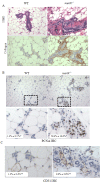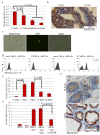Epithelial cell-directed efferocytosis in the post-partum mammary gland is necessary for tissue homeostasis and future lactation
- PMID: 21192804
- PMCID: PMC3022573
- DOI: 10.1186/1471-213X-10-122
Epithelial cell-directed efferocytosis in the post-partum mammary gland is necessary for tissue homeostasis and future lactation
Abstract
Background: Mammary glands harbor a profound burden of apoptotic cells (ACs) during post-lactational involution, but little is known regarding mechanisms by which ACs are cleared from the mammary gland, or consequences if this process is interrupted. We investigated AC clearance, also termed efferocytosis, during post-lactational remodeling, using mice deficient for MerTK, Axl, and Tyro3, three related receptor tyrosine kinases (RTKs) regulating macrophage-mediated efferocytosis in monocytes. MerTK expression, apoptosis and the accumulation of apoptotic debris were examined in histological sections of MerTK-deficient, Axl/Tyro3-deficient, and wild-type mammary glands harvested at specific time points during lactation and synchronized involution. The ability of primary mammary epithelial cells (MECs) to engulf ACs was assessed in culture. Transplant of MerTK-deficient mammary epithelium into cleared WT mammary fat pads was used to assess the contribution of WT mammary macrophages to post-lactational efferocytosis.
Results: ACs induced MerTK expression in MECs, resulting in elevated MerTK levels at the earliest stages of involution. Loss of MerTK resulted in AC accumulation in post-lactational MerTK-deficient mammary glands, but not in Axl and Tyro3-deficient mammary glands. Increased vascularization, fibrosis, and epithelial hyperproliferation were observed in MerTK-deficient mammary glands through at least 60 days post-weaning, due to failed efferocytosis after lactation, but did not manifest in nulliparous mice. WT host-derived macrophages failed to rescue efferocytosis in transplanted MerTK-deficient mammary epithelium.
Conclusion: Efferocytosis by MECs through MerTK is crucial for mammary gland homeostasis and function during the post-lactational period. Efferocytosis by MECs thus limits pathologic consequences associated with the apoptotic load following lactation.
Figures







Similar articles
-
Overexpression of MERTK receptor tyrosine kinase in epithelial cancer cells drives efferocytosis in a gain-of-function capacity.J Biol Chem. 2014 Sep 12;289(37):25737-49. doi: 10.1074/jbc.M114.570838. Epub 2014 Jul 29. J Biol Chem. 2014. PMID: 25074939 Free PMC article.
-
Macrophages and dendritic cells use different Axl/Mertk/Tyro3 receptors in clearance of apoptotic cells.J Immunol. 2007 May 1;178(9):5635-42. doi: 10.4049/jimmunol.178.9.5635. J Immunol. 2007. PMID: 17442946
-
Enhanced efferocytosis of apoptotic cardiomyocytes through myeloid-epithelial-reproductive tyrosine kinase links acute inflammation resolution to cardiac repair after infarction.Circ Res. 2013 Sep 27;113(8):1004-12. doi: 10.1161/CIRCRESAHA.113.301198. Epub 2013 Jul 8. Circ Res. 2013. PMID: 23836795 Free PMC article.
-
Targeting Tyro3, Axl and MerTK (TAM receptors): implications for macrophages in the tumor microenvironment.Mol Cancer. 2019 May 14;18(1):94. doi: 10.1186/s12943-019-1022-2. Mol Cancer. 2019. PMID: 31088471 Free PMC article. Review.
-
Tyro3, Axl, Mertk receptor-mediated efferocytosis and immune regulation in the tumor environment.Int Rev Cell Mol Biol. 2021;361:165-210. doi: 10.1016/bs.ircmb.2021.02.002. Epub 2021 May 10. Int Rev Cell Mol Biol. 2021. PMID: 34074493 Review.
Cited by
-
Mechanisms of Macrophage Plasticity in the Tumor Environment: Manipulating Activation State to Improve Outcomes.Front Immunol. 2021 May 7;12:642285. doi: 10.3389/fimmu.2021.642285. eCollection 2021. Front Immunol. 2021. PMID: 34025653 Free PMC article. Review.
-
The Cellular Organization of the Mammary Gland: Insights From Microscopy.J Mammary Gland Biol Neoplasia. 2021 Mar;26(1):71-85. doi: 10.1007/s10911-021-09483-6. Epub 2021 Apr 9. J Mammary Gland Biol Neoplasia. 2021. PMID: 33835387 Review.
-
Mammary epithelial cell phagocytosis downstream of TGF-β3 is characterized by adherens junction reorganization.Cell Death Differ. 2016 Feb;23(2):185-96. doi: 10.1038/cdd.2015.82. Epub 2015 Jun 26. Cell Death Differ. 2016. PMID: 26113040 Free PMC article.
-
The Role of TAM Family Receptors in Immune Cell Function: Implications for Cancer Therapy.Cancers (Basel). 2016 Oct 21;8(10):97. doi: 10.3390/cancers8100097. Cancers (Basel). 2016. PMID: 27775650 Free PMC article. Review.
-
Receptor tyrosine kinases, TYRO3, AXL, and MER, demonstrate distinct patterns and complex regulation of ligand-induced activation.J Biol Chem. 2014 Sep 12;289(37):25750-63. doi: 10.1074/jbc.M114.569020. Epub 2014 Jul 29. J Biol Chem. 2014. PMID: 25074926 Free PMC article.
References
-
- Stein T, Morris JS, Davies CR, Weber-Hall SJ, Duffy MA, Heath VJ, Bell AK, Ferrier RK, Sandilands GP, Gusterson BA. Involution of the mouse mammary gland is associated with an immune cascade and an acute-phase response, involving LBP, CD14 and STAT3. Breast Cancer Res. 2004;6(2):R75–91. doi: 10.1186/bcr753. - DOI - PMC - PubMed
Publication types
MeSH terms
Substances
Grants and funding
LinkOut - more resources
Full Text Sources
Molecular Biology Databases
Research Materials
Miscellaneous

